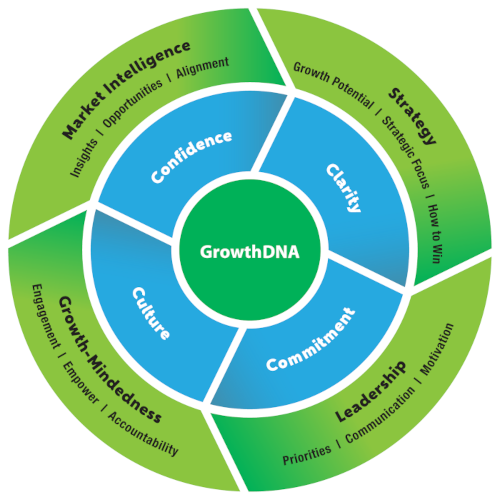One of the things we can count on is change. We have it in abundance right now, with market shifts responding to new government policies as well as AI taking off without us in a driver’s seat. What happens when leaders face a future that doesn’t look like the past? Often, they retreat to their comfort zone. Or they try to step up with a new plan, but it is hard to mobilize a new future when we leverage historical experience and success to solve new problems. The great John Kotter broke down leadership responsibilities into three fundamental categories: articulating a compelling vision, aligning people around it and motivating them to execute it. Easy peazy! Easy to say that is, but not easy to do. It is why GrowthDNA™, our leadership growth model, works. It isn’t enough that you do these things—it is how you do them.
GrowthDNA™, starts with Market Intelligence. It is hard to articulate a strategy if you don’t have and accept current data about the market. What you used to do may not be what you need to do now. I am working with a client who has had the premium product in their industry for so long but now, some customers are saying it is not needed in every situation—sometimes, good is good enough, especially when it carries a 25% discount. What does the leader do? Do they double down on a premium approach finding a way to add value through services or expertise, or do they offer some SKUs with reduced requirements and price, or do they combine the two? What does the data say? Can you change strategy that far without it hurting the rest of your business? See the article on Southwest airlines that is muddying the waters on their low-cost position here: Keeping Up With the Market – Can it be Fatal 3_30_25.pdf.
According to an article in the Harvard Business Review January-February 2024 issue titled, Why Real-Time Leadership is So Hard, there are times when businesses think they have no alternatives but to change the strategy. They mention that habits, processes, social norms, historical biases, reward systems, and experiences argue for the status quo or modified status quo. They call it the “I’ll try harder” trap. Starting with data makes it harder to fall back into the comfort zone and easier to identify new opportunities that leverage current strengths. Often new innovative approaches to the market may be required, but not necessarily a change in fundamental strategy which is rare and hard to pull off. Only after understanding the market and determining where to play and how to win in that segment going forward, can you cement Strategy, the second element of GrowthDNA™.
Next, achieving alignment requires time for the executives to become evangelists regarding the strategic approach. If data builds the case for it, how do you get others on board? The decisions we make in the boardroom can rarely be achieved there. They require all employees top to bottom to engage, not just punch a clock. We often feel we have no time but indeed, we manage the priorities and the calendar. There is no one but us to consider if we feel a lack of time to do the things required for success.
Ask, “What can we stop doing that no one will even miss?” and “Where can I spend my time that has the largest ROI for the organization?”. I have been a part of organizations that just wait out the latest strategic initiative because there is a track record of always moving on to the next shiny thing, or accepting that there is too much to do to implement strategy—day to day fires take precedent. Well, interestingly, if the organization focused on the important things and dismantled things that are less important, there may just be fewer day-to-day fires. Customer segmentation, focusing scarce resources on the right customers, is one way to make that happen. In GrowthDNA™ language, the transition from working on daily activities to working on strategically aligned activities is called developing Commitment. The number one way to do that is for leadership to communicate—the priorities, the expectations, the invitation to be involved, timelines, accountabilities, new processes needed, etc. Communication should never stop. It needs to be a drum beat that people can hear daily. It needs to be consistent—across departments, and two-way. Leadership needs to hear what the front-line employees understand and think and respond to that so all can be working together for maximum performance.
Finally, when effective communication is established, that is when the focus becomes motivation and ongoing commitment through a link to Culture. If alignment takes into account formal priorities and processes, culture is the day-to-day customs that make it real. If employees are engaged, then the strategy will be sustainable. If not, leaders will wear out trying to do it all themselves or step in every time something doesn’t happen. A culture needs to be growth minded in addition to all the fabulous values that a company has cultivated. GrowthDNA™ describes growth-mindedness as employees adding value beyond their job description. In other words, they are not just checking boxes or passing paper but they understand where the organization is going, are committed to helping and finally, see how they can make a difference. Without this last piece, most strategic work fizzles and underperforms, or dies.

The bottom line is that leaders must respond to change every day. How they do it matters. They need to be able to dissect change, and be open to seeing things differently, through the eyes of the market, not their historical strategy or experience. It is like dumping jigsaw puzzle pieces on a table and not following the picture on the box cover but recreating a new picture, leveraging strengths, not using pieces that get in the way or are not a part of the future, and re-imagining a new future. You may be surprised how far your company can grow.

